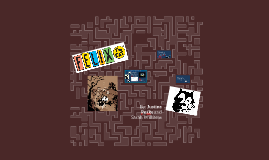Cartoon Characters
Transcript: By: Justine Peake and Sarah Williams Personality These are some of Felix's original pictures from 1919. There is also a video of some of the work he's been drawn into. We also have a photo of the creator of Felix, Otto Messmer. There is also a graph of Felix's popularity over the years. Felix the cat was created by Otto Messmer. Felix's first appearance was in "Feline Follies" in the 1900's. Otto Messmer was an American animator from New Jersey. Felix's image was the very first image to be broadcast over television airwaves. Felix the Cat was a thinking character. had wit as fast and sharp as a razor who could improvise to any situation on the blink of an eye. had a wide range of emotions and thoughts, which were resulted due to his large eyes. also had a detachable, shapeshifting tail Media Of Favorite Moments Favorite Moments Media of Felix FELIX The Twisted Tale of the World's Most Famous Cat. By John Canemaker. Illustrated. 177 pp. New York: Pantheon Books. $30. Amazing, really, that barely a penny's worth of black ink could have inspired such lively emotions and such expensive litigation. But then, when applied to paper by the talented pen of the artist Otto Messmer, the ink became immeasurably more than an inkblot. It became Felix, the cat with the killer personality, the first fully realized animal character in the history of American film animation -- "the one film star," a British critic of the 20's enthused, "who intrigues me." Felix was a cat and a commodity, the commercial exploitation of which would remain unmatched until the matriculation of Mickey Mouse a decade after Felix's debut in 1919. If Felix was exploited by Pat Sullivan, the man who produced his 150 or so animated adventures in the 1920's, so, as John Canemaker convincingly demonstrates in "Felix," was Felix's true "father": his animator, Otto Messmer, an almost pathologically diffident man. Messmer's creative contributions to Felix's career went unacknowledged until the 1970's, when a series of retrospectives and a well-received documentary film by Mr. Canemaker himself finally gave credits where credits were due (only Sullivan's name -- as producer and accomplished self-promoter -- appeared on the Felix films). Even then Messmer had to be dragged into the limelight ("Like the cartoons, I am silent," he told a crowd at New York's Museum of Modern Art). While freely acknowledging Sullivan's entrepreneurial skills, Mr. Canemaker has less sympathy for the man's monumental weaknesses. He candidly reports Sullivan's alcoholism ("He couldn't stop that drinking," Messmer tut-tutted in an interview with the author. "Terrible.") and his compulsive philandering (He spent nine months in Sing Sing in 1917-18 after he was convicted of raping a 14-year-old girl). Most significant of Sullivan's character quirks, however, was what Mr. Canemaker calls his "proprietary paranoia regarding Felix's ownership," which resulted in continuous, acrimonious and complicated litigation with Margaret Winkler, the first woman producer and distributor of animated films, whose spirited selling of the Felix shorts spurred the feline's rise to international fame in the 1920's. It was Sullivan's paranoia that contributed as well to Felix's precipitous fall from fame following the producer's death from chronic alcoholism in 1933. Messmer, the one man who could conceivably have shepherded Felix into a new era of popularity, was left with no proprietary rights whatsoever, and the three Felix cartoons produced in the 30's without his participation were dismal failures -- and not only because Messmer was missing. As Mr. Canemaker, himself an animator, astutely points out, "Sound, color, full animation, a cast of hundreds, and Disney-like illusory special effects diminished rather than enhanced [ Felix's ] essence." As a black-and-white silent character Felix had the elegance of simplicity, of course. But beyond that there had been something in his personality that epitomized the spirit of the Jazz Age. For a cartoon character, Felix had a decidedly adult sensibility, a fondness for speakeasies and a weakness for whoopee. When he was finally given a voice in the 30's, and a character to match, they were appallingly like Mickey Mouse's at their little-boy, gee-whiz worst and totally antithetical to the breezy insouciance of the character who had captured the heart -- and spirit -- of an age. More than anything, this spelled "Fin" to the cat's career. If Felix today is like the Gabor sisters -- famous only for being famous -- he was once a genuine star, as Mr. Canemaker's affectionate biography convincingly demonstrates. More than a star, in fact: the essence of an era. Not bad for barely a penny's worth of black ink. Article of Felix the Cat History of Felix the Cat when in "Feline Follies," he was standing in the mirror Made his tail go up and down mice came out rejoicing that he was gone the mice break everything while he is out with his girlfriend Media of Felix the Cat

















